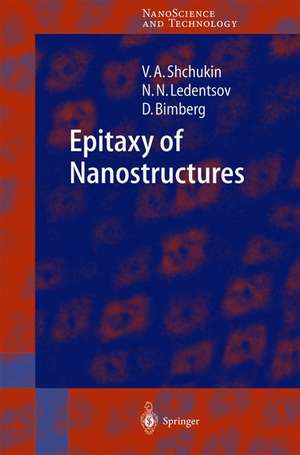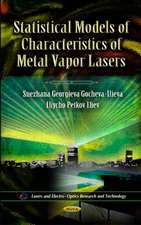Epitaxy of Nanostructures: NanoScience and Technology
Autor Vitaly Shchukin, Nikolai N. Ledentsov, Dieter Bimbergen Limba Engleză Hardback – 9 oct 2003
| Toate formatele și edițiile | Preț | Express |
|---|---|---|
| Paperback (1) | 1045.57 lei 38-44 zile | |
| Springer Berlin, Heidelberg – 4 dec 2010 | 1045.57 lei 38-44 zile | |
| Hardback (1) | 1232.26 lei 6-8 săpt. | |
| Springer Berlin, Heidelberg – 9 oct 2003 | 1232.26 lei 6-8 săpt. |
Din seria NanoScience and Technology
- 24%
 Preț: 905.79 lei
Preț: 905.79 lei - 18%
 Preț: 1123.35 lei
Preț: 1123.35 lei - 18%
 Preț: 964.71 lei
Preț: 964.71 lei - 18%
 Preț: 1121.76 lei
Preț: 1121.76 lei - 15%
 Preț: 655.60 lei
Preț: 655.60 lei - 18%
 Preț: 1390.11 lei
Preț: 1390.11 lei - 18%
 Preț: 954.31 lei
Preț: 954.31 lei - 15%
 Preț: 645.79 lei
Preț: 645.79 lei - 18%
 Preț: 953.03 lei
Preț: 953.03 lei - 18%
 Preț: 945.79 lei
Preț: 945.79 lei - 15%
 Preț: 639.90 lei
Preț: 639.90 lei - 18%
 Preț: 1109.16 lei
Preț: 1109.16 lei - 23%
 Preț: 779.87 lei
Preț: 779.87 lei - 18%
 Preț: 944.99 lei
Preț: 944.99 lei - 18%
 Preț: 957.62 lei
Preț: 957.62 lei - 18%
 Preț: 971.01 lei
Preț: 971.01 lei - 18%
 Preț: 1232.26 lei
Preț: 1232.26 lei - 18%
 Preț: 960.30 lei
Preț: 960.30 lei - 15%
 Preț: 646.62 lei
Preț: 646.62 lei - 18%
 Preț: 1249.31 lei
Preț: 1249.31 lei - 15%
 Preț: 636.80 lei
Preț: 636.80 lei - 24%
 Preț: 821.43 lei
Preț: 821.43 lei - 18%
 Preț: 948.92 lei
Preț: 948.92 lei - 24%
 Preț: 1827.89 lei
Preț: 1827.89 lei - 18%
 Preț: 951.91 lei
Preț: 951.91 lei - 24%
 Preț: 794.21 lei
Preț: 794.21 lei - 18%
 Preț: 953.03 lei
Preț: 953.03 lei - 23%
 Preț: 782.55 lei
Preț: 782.55 lei - 18%
 Preț: 952.57 lei
Preț: 952.57 lei - 18%
 Preț: 948.16 lei
Preț: 948.16 lei - 18%
 Preț: 954.93 lei
Preț: 954.93 lei - 24%
 Preț: 809.40 lei
Preț: 809.40 lei - 23%
 Preț: 781.25 lei
Preț: 781.25 lei - 18%
 Preț: 954.93 lei
Preț: 954.93 lei - 18%
 Preț: 1830.34 lei
Preț: 1830.34 lei - 15%
 Preț: 641.71 lei
Preț: 641.71 lei - 18%
 Preț: 1228.96 lei
Preț: 1228.96 lei - 18%
 Preț: 1120.37 lei
Preț: 1120.37 lei - 18%
 Preț: 956.81 lei
Preț: 956.81 lei - 15%
 Preț: 592.59 lei
Preț: 592.59 lei - 18%
 Preț: 953.65 lei
Preț: 953.65 lei - 18%
 Preț: 954.62 lei
Preț: 954.62 lei - 18%
 Preț: 955.25 lei
Preț: 955.25 lei - 18%
 Preț: 959.19 lei
Preț: 959.19 lei - 18%
 Preț: 953.35 lei
Preț: 953.35 lei - 18%
 Preț: 786.84 lei
Preț: 786.84 lei
Preț: 1232.26 lei
Preț vechi: 1502.76 lei
-18% Nou
Puncte Express: 1848
Preț estimativ în valută:
235.82€ • 245.29$ • 194.69£
235.82€ • 245.29$ • 194.69£
Carte tipărită la comandă
Livrare economică 12-26 aprilie
Preluare comenzi: 021 569.72.76
Specificații
ISBN-13: 9783540678175
ISBN-10: 3540678174
Pagini: 404
Ilustrații: XII, 388 p.
Dimensiuni: 155 x 235 x 30 mm
Greutate: 0.86 kg
Ediția:2004
Editura: Springer Berlin, Heidelberg
Colecția Springer
Seria NanoScience and Technology
Locul publicării:Berlin, Heidelberg, Germany
ISBN-10: 3540678174
Pagini: 404
Ilustrații: XII, 388 p.
Dimensiuni: 155 x 235 x 30 mm
Greutate: 0.86 kg
Ediția:2004
Editura: Springer Berlin, Heidelberg
Colecția Springer
Seria NanoScience and Technology
Locul publicării:Berlin, Heidelberg, Germany
Public țintă
ResearchCuprins
1. Introduction.- 2. Growth and Characterization Techniques.- 3. Self-Organization Phenomena at Crystal Surfaces.- 4. Engineering of Complex Nanostructures: Working Together with Nature.- 5. Devices Based on Epitaxial Nanostructures.- 6. Conclusion.- A. Energy of a Strained Disk with Perturbed Shape.- A.1 Energy of the Disk Boundary.- A.2 Elastic Relaxation Energy of the Disk.- A.3 Evaluation of Integrals.- A.4 Stiffness of the Disk against Shape Perturbations.- B. Elastic Interaction of Two Strained Disks.- C. Stiffness of a Hexagonal Array of Interacting Strained Disks.- References.
Recenzii
From the reviews:
"The book focuses on the physical mechanisms behind the spontaneous formation of ordered nanostructures … . The list of chapters give a good indication on the points of view of the authors. … Most books on nanophysics deal with isolated nanosystems, or nanosystems in solutions. This one gives a good overview of deposited nanostructures. It will then be helpful to researchers working or entering the specific field of research, but also to people coming from the thin films or interface fields." (Michel Wautelet, Physicalia, Vol. 57 (3), 2005)
"This monograph is a detailed account of the theory and practice of growth, characterization and applications of quantum-dot nanostructures (of mainly compound semiconductors) in real devices, written by a group of leading experts in the field … which makes it an invaluable asset in any nanostructure–growth laboratory. … this monograph, aimed at the postgraduate and specialist level, is excellent on so many levels that I strongly recommend it to scientists engaged in nanostructure research and to those who consider entering this fascinating field." (Dr I. O. Goldfarb, Contemporary Physics, Vol. 46 (3), 2005)
"This book is intended to explain to at least a postgraduate and above, the mechanisms, growth processes, analytical characterisation techniques and, ultimately, the potential areas of application of epitaxial nanostructures … . this book makes a very informative introduction and guide to the complex world of epitaxial nanostructures and is well worth the asking price." (Paul Cannard, Materials World, Vol. 13 (2), February, 2005)
"The book focuses on the physical mechanisms behind the spontaneous formation of ordered nanostructures … . The list of chapters give a good indication on the points of view of the authors. … Most books on nanophysics deal with isolated nanosystems, or nanosystems in solutions. This one gives a good overview of deposited nanostructures. It will then be helpful to researchers working or entering the specific field of research, but also to people coming from the thin films or interface fields." (Michel Wautelet, Physicalia, Vol. 57 (3), 2005)
"This monograph is a detailed account of the theory and practice of growth, characterization and applications of quantum-dot nanostructures (of mainly compound semiconductors) in real devices, written by a group of leading experts in the field … which makes it an invaluable asset in any nanostructure–growth laboratory. … this monograph, aimed at the postgraduate and specialist level, is excellent on so many levels that I strongly recommend it to scientists engaged in nanostructure research and to those who consider entering this fascinating field." (Dr I. O. Goldfarb, Contemporary Physics, Vol. 46 (3), 2005)
"This book is intended to explain to at least a postgraduate and above, the mechanisms, growth processes, analytical characterisation techniques and, ultimately, the potential areas of application of epitaxial nanostructures … . this book makes a very informative introduction and guide to the complex world of epitaxial nanostructures and is well worth the asking price." (Paul Cannard, Materials World, Vol. 13 (2), February, 2005)
Textul de pe ultima copertă
The main focus of the book are the physical mechanisms behind the spontaneous formation of ordered nanostructures at semiconductor surfaces. These mechanisms are at the root of recent breakthroughs in advanced nanotechnology of quantum-wire and quantum-dot fabrication. Generic theoretical models are presented addressing formation of all basic types of nanostructures, including periodically faceted surfaces, arrays of step-bunches of equal heights and single- and multi-sheet arrays of both 2- and 3-D strained islands. Decisive experiments on both structural and optical characterization of nanostructures are discussed to verify theoretical models and link them to practical examples. The book also describes experimental tools in nanoengineering that enable one to intentionally control the parameters of self-organized nanostructures, such as chemical composition, shape, size, density and relative arrangement of quantum dots and wires. Practical applications of nanoepitaxial technologies are discussed in the framework of recent advances in quantum dot lasers.
Caracteristici
Will be the first Springer book in the field of formation of nanodevices by self-organized growth Includes supplementary material: sn.pub/extras














